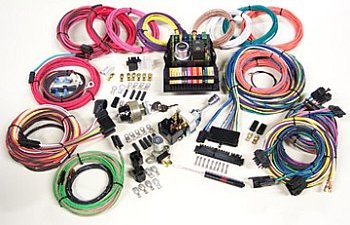Automotive Wire Size Calculator
This is a simple calculator for determining or estimating the approximate size of a wire based on the length of the wire run, and the
current for general Automotive use. This can be helpful if doing you own repairs or using a pre-built wiring harness to make sure each
circuit is not overloaded. When doing automotive wiring it is important to use the proper wire in the proper place, and this also goes for
the operating temperatures of wire plastic casings, you don't want to run common cheep wire in a hot engine compartment, so make
sure that you know the temperature ratings and when important to run higher rated temperature wiring. You may see wires with specs
like -
GPT (SAE J1128-GPT) - General Purpose Wire rated -40F to 176F
SXL (SAE J1128-SXL) - Standard insulation, Automotive Cross-link Wire rated -49F to 257F
GXL (SAE J1128-GXL) - Thin insulation, Automotive Cross-link Wire rated -49F to 257F
TXL (SAE J1128-TXL) - Extra thin insulation, Automotive Cross-link Wire rated -49F to 257F
SXL, GXL, and TXL wires are oil, gas, acid and generally chemical proof. One other note about wire type is Teflon and Tefzel are
generally very good wire but expensive. And always check the ratings, I have seen Teflon wires with a temp rating of 105C (221F)
which is below the typical Cross-linked as indicated above. If your going to get Teflon or Tefzel wire and it's good it will be silver plated
conductors and expensive. Typical temperature range for Teflon is -60C to 200C (-76F to 392F) and Tefzel is -70C to 150C (-94 to
302F). Sometime you may see wire called PTFE, PTF for Teflon as well. A few sources exist for Teflon wires, aircraft supply, surplus
sometimes, even a few racing places are starting to sell it.
The voltage drop value varies depending on what your application. I prefer using the 2% mark as a very safe value as well as delivering
full potential to any needed electrical source. From what it looks like in many automotive applications a 5% or more voltage drop is
more common and acceptable. Choose towards the smaller number if possible.
Some common rules : the smaller the diameter of the wire the higher the resistance and thus lower current capability over a given
length. It is almost always OK to use a larger gauge wire. When in doubt about the load go up a gauge. Other factors can affect the
capacity of wire besides the length, and this includes if it is in a hot environment, duration of load, stranded vs. solid wire, wire plating.
Some aircraft Teflon wires have high strand count and are silver plated. These wires have higher capacity then typical copper stranded
wires. Check out Wikipedia for more info on wires (AWG, Brown and Sharpe), gauges, and the math. Approximate Metric Wire Sizes
Equivalents (with some rounding) are also include in the table as diameter/area and are in millimeters/square millimeters [mm/mm2],
and again use larger size if in question.
For more information on Automotive Electrical systems, here is a Toyota Training document that I found that is a nice starting point and
give a good overview of many electrical principles - Basic Automotive Electrical Theory
To use the calculator, enter the Maximum Current in Amps of the circuit, and the Length of the Wire, and operating Voltage. Typically
most automotive systems run at 13.8V, but you can select 6, 12, 13.8 (Default) or 24 volts. If the wire gauge is OK to use it will have a
'Check Mark' on the same line. The 'Max Length' indicates the maximum length of wire of that gauge that can be use at the given
values you entered.
Last Note : This is for a ONE WAY wire with the ground assumed to be the car chassis. If 2 wires needed to complete the circuit
calculate for the total length of BOTH wires.



